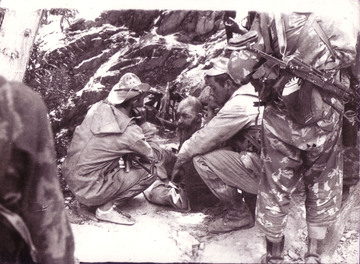Corey's US Involvement in Soviet Afghan war
The U.S. Involvement
Prior to U.S. involvement in the Soviet Afghan war the soviets had covertly invaded Afghanistan with their special forces. [2] They were sent there to quell the growing rebellious disposition and make sure their communist leaders remained in power. The Afghan rebel group, Mujahedin, was getting tired of the communist rule which allowed women many more freedoms then their religion would accept. As the uprising began in 1979, the national security advisor at the time, Dr. Zbigniew Brzezinski, took notice and when the soviets formally invaded Afghanistan he advised President Jimmy Carter to go with the CIA’s plan to assist the rebels in financing the war. The day after the invasion took place Dr. Brzezinski exclaimed to President Carter, “We now have the opportunity of giving to the USSR its Vietnam War.” [1] The CIA was working closely with the Pakistani intelligence agencies to help set up fronts for the transfer of funds and arms across the border between Afghanistan and Pakistan. [2] During this time a man by the name of Osama bin Laden had joined the insurgents and was quickly rising in rank. By 1984, bin Laden had established himself as leader in rebellion against the soviet oppression. President Reagan stepped up the assault during the 1980’s by providing the Mujahedeen with lethal weapons through pacts with allied nations. The most noteworthy weapon the CIA handed out was the FIM-92 stinger missile. Again Dr. Brzezinski was consulted about the possibility of arming the rebels with these anti-aircraft missiles and he approved of the concept. [1] The soviets had been utilizing their Hind helicopters with devastating effect, but now they were vulnerable in a big way. This caused the U.S.S.R. to completely rethink their strategy. Without air support they struggled to overcome the challenges of the mountainous terrain. This was indeed a turning point in the war that would ultimately lead to a stalemate and the withdrawal of soviet military forces. Even so, Dr. Brzezinski contests that even without the support provided by the United States the insurgents would have continued to fight with the help of several nations from the Persian Gulf who had been matching the funds of the U.S. aid. [1] By war’s end in 1989 the United States had supplied over $3 billion to the Mujahedin along with filling their arsenals full of the latest military equipment. [3]
The Consequences
After the Soviet Afghan war, several warlords from the now splintered rebel faction engaged in another civil war with more innocent bloodshed on a magnitude comparable to that of the American Civil war. Eventually a new radical group, the Taliban, came to power led by none other than Osama bin Laden. [2] Other radical organizations found refuge in the newly independent Afghanistan. One of the more prominent syndicates was al Qaeda. The growing influence of al Qaeda, the Taliban, and anti-western prejudice is what led to the 9/11 attacks. [1] It also led to the United States’ current predicament with the war in Afghanistan that is turning out to be another Vietnam funded on both fronts by the U.S.
Sources
1. ^ Jay, Paul. "The Afghan War and the 'Grand Chessboard' Pt2." The Real News. TRNN. 15 Jan. 2010. Http://therealnews.com. The Real News Network. Web. 27 Sept. 2011. <http://therealnews.com/t2/index.php?Itemid=74&id=31&jumival=4716&option=com_content&task=view>.
2. ^ "Afghanistan: Lessons from the Last War." The National Security Archive. Ed. John Prados. The George Washington University, 9 Oct. 2001. Web. 27 Sept. 2011. <http://www.gwu.edu/~nsarchiv/NSAEBB/NSAEBB57/us.html>.
3. ^ Dreyfuss, Robert. "Your Tax Dollars at War." Academic Search Premier. EBSCO, May-June 2009. Web. 27 Sept. 2011. <http://web.ebscohost.com/ehost/detail?vid=9&hid=111&sid=90621a34-ae05-41d5-b418-cbf303f3dc48%40sessionmgr112&bdata=JnNpdGU9ZWhvc3QtbGl2ZQ%3d%3d#db=aph&AN=38705111>.
2. ^ "Afghanistan: Lessons from the Last War." The National Security Archive. Ed. John Prados. The George Washington University, 9 Oct. 2001. Web. 27 Sept. 2011. <http://www.gwu.edu/~nsarchiv/NSAEBB/NSAEBB57/us.html>.
3. ^ Dreyfuss, Robert. "Your Tax Dollars at War." Academic Search Premier. EBSCO, May-June 2009. Web. 27 Sept. 2011. <http://web.ebscohost.com/ehost/detail?vid=9&hid=111&sid=90621a34-ae05-41d5-b418-cbf303f3dc48%40sessionmgr112&bdata=JnNpdGU9ZWhvc3QtbGl2ZQ%3d%3d#db=aph&AN=38705111>.

